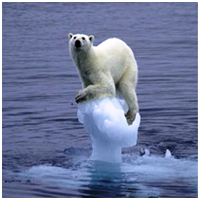 Matter
Matter
If you pay attention to various matters around you, such as a pencil, a rock, water, and air that you breathe, then you will find that those things are in the forms of solids, liquids or gasses. Matter can be classified into solid, liquid, or gas. Matter consist of tiny part called particle. The particles are so tiny that cannot be seen by naked eyes. The particles composition determinates the state of matter, whether it is solid, liquid, or gas
 |
 |
 |
|
|
gas |
liquid |
solid |
|
A solid has a definite shape and volume, occupies a constant amount of space and does not readily deform when pressure is applied. The attractions between particles are strong enough to hold them in some fixed three dimensional arrangement despite their random, thermal motion. The particle are able to vibrate about fixed positions, but they cannot move past one another. Adding heat causes these vibrations to in-crease until, at a certain temperature, the vibrations are strong enough to dis-rupt the fixed arrangement. The particles can then slip past one another and tumble around, much like a bunch of marbles in a bag
A liquid has a definite volume but it takes the shape of a container whereas a gas fills the entire volume of a container. It is the mobility of atoms or molecules in this state that gives rise to the liquid’s fluid character, its ability to flow and take on the shape of its container. Further heating causes the particles in the liquid to move with such high amplitude vibrations that the attractions they have for one another can’t hold them together. They then separate from one another, forming a gas. The speed of the atoms or molecules in a gas depends on the temperature of the gas. At room temperature (25°C), the atoms or molecules move at an average speed of some 500 meters per second (1100 miles per hour). The particles move in straight lines until they collide with one another or with the walls of their container, then they bounce away from one another like billiard balls in a game of pool. Because they bounce back after colliding, the particles of a gas become widely separated.
A gas has neither definite volume nor definite shape. Any sample of gas assumes both the shape and the volume of the container it occupies. Matter in the gaseous phase therefore occupies much more volume than it does in the solid or liquid phase. Applying pressure to a gas squeezes the gas particles closer together, which makes for a smaller volume. Enough air for an underwater diver to breathe for many minutes
Changing States of Matter

Have you ever watched your mother boiling water? When the water is boiling, but you keep heating it for some time, the volume of the water is decreasing, and finally there is no water left in the container. Where does it go?
The water evaporates into a gas. The states of matter are able to change. The previous illustration shows the ability of water to change its state from liquid into gas. Find other example of changes in states of matter in your everyday life!
picture 2. the diagram of changes in states of matter
Melting is the change from a solid to a liquid. Vaporization is the change from a liquid to a gas. Condensation is the change from a gas to a liquid. Solidification, or freezing, is the change from a liquid to a solid. Sublimation is the change from a solid directly to a gas, deposition is the change from a gas to a solid.
Source from book:
Hewitt, paul et al. 2007. Conceptual Integrated science. United state Of America: Pearson Education, Inc
Source from Internets:
Learn state properties of matter on http://www.safeathomewithleo.com
States of matter on http://www.education.uoit.ca
Source of picture:
Change state of matter on http://www.sciencewithmrmilstid.com
Solid, liquid and gas on http://www.glogster.com